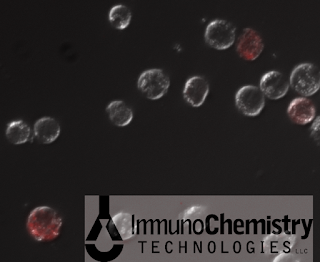Greetings to you in this festive holiday week! As I imagine to be true for labs and offices around the country, holiday traditions have been a lively point of conversation among ICT scientists, colleagues, and customers this month. In particular, the great tradition of preparing a holiday feast - with a turkey - has garnered a lot of attention:
the working concept behind brining a turkey is similar to that of our FLICA caspase assay! Both procedures work by utilizing cell-permeant molecules and the principle of diffusion. (You don't end up with a fluorescent turkey.)
The purposes and results, of course, are quite different: one provides a moist turkey for your holiday feast (hopefully), while the latter provides an easily analyzed answer to an investigation of apoptosis (reliably!).
Of course, brining a turkey is more than diffusion (and as some claim, osmosis, to some extent); oh no, there is one more fabulous scientific principle at play: denaturing. The increase in the salt concentration in the meat denatures protein strands, which causes them to retain more water during cooking, resulting in a moist and flavorful meal.
Wishing you all Joyful Holidays and a Prosperous New Year!
Fun sources:
http://gizmodo.com/5862312/brine-your-turkey-fool-its-science
http://science.kqed.org/quest/2009/11/25/the-science-behind-brining/
http://www.virtualweberbullet.com/brining.html
More information about our cell-permeant protease and apoptosis detection assays:
http://www.immunochemistry.com/products/apoptosis-assays.html
http://www.immunochemistry.com/products/apoptosis-assays/flica.html

©2011 ImmunoChemistry Technologies, LLC. All Rights Reserved. | Bright Minds, Bright Solutions.
- The logistics of arranging dinner for 25 humans and 6+ four-legged friends.
- "Yams" vs. "sweet potatoes."
- To bag or not to bag.
- How not to use a turkey fryer. [Have you seen William Shatner's video?]
- And brining a turkey - "... wait, isn't brining for pickles?"
the working concept behind brining a turkey is similar to that of our FLICA caspase assay! Both procedures work by utilizing cell-permeant molecules and the principle of diffusion. (You don't end up with a fluorescent turkey.)
Of course, brining a turkey is more than diffusion (and as some claim, osmosis, to some extent); oh no, there is one more fabulous scientific principle at play: denaturing. The increase in the salt concentration in the meat denatures protein strands, which causes them to retain more water during cooking, resulting in a moist and flavorful meal.
- enzymatic affinities for particular peptide sequences (e.g. V-A-D is targeted by all caspases)
- ability of our proprietary caspase inhibitor reagents to form covalent bonds with the active sites of caspase enzymes
- and again, diffusion of unbound reagent from the cell during wash steps
Wishing you all Joyful Holidays and a Prosperous New Year!
Fun sources:
http://gizmodo.com/5862312/brine-your-turkey-fool-its-science
http://science.kqed.org/quest/2009/11/25/the-science-behind-brining/
http://www.virtualweberbullet.com/brining.html
More information about our cell-permeant protease and apoptosis detection assays:
http://www.immunochemistry.com/products/apoptosis-assays.html
http://www.immunochemistry.com/products/apoptosis-assays/flica.html
©2011 ImmunoChemistry Technologies, LLC. All Rights Reserved. | Bright Minds, Bright Solutions.

No comments:
Post a Comment